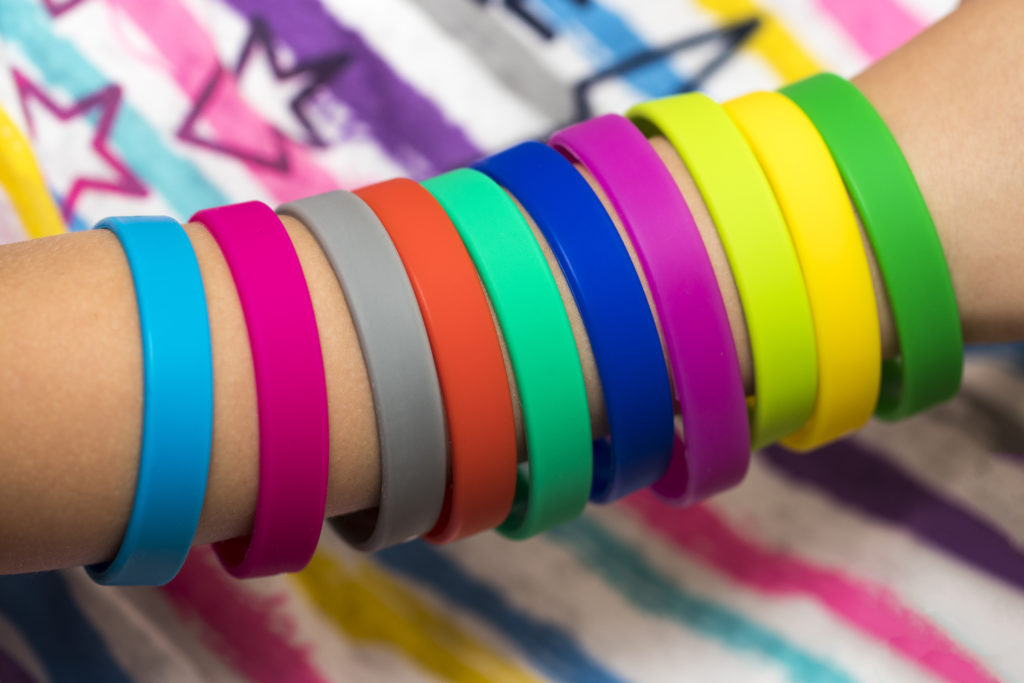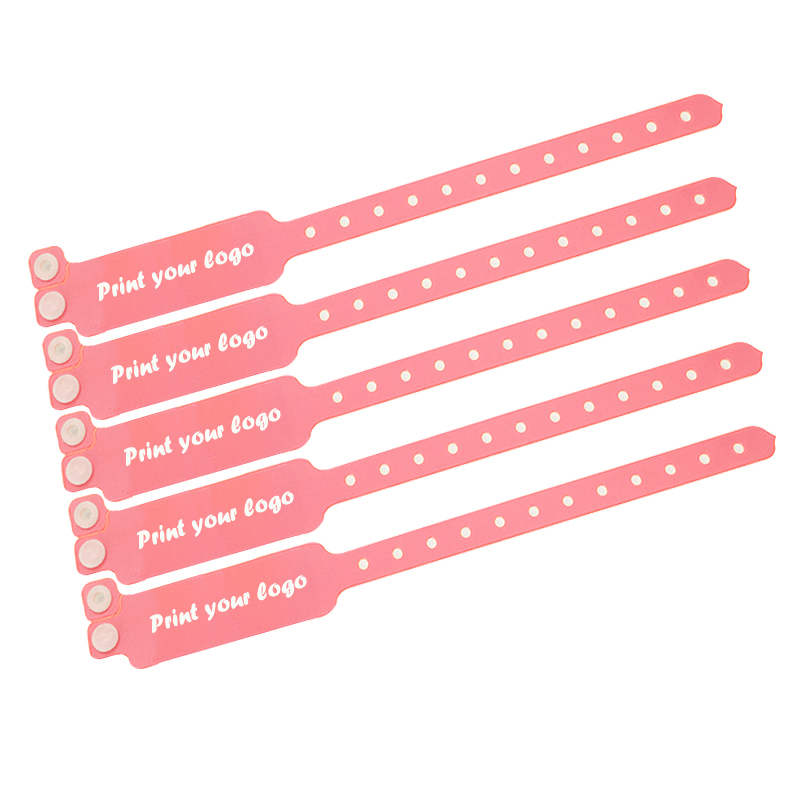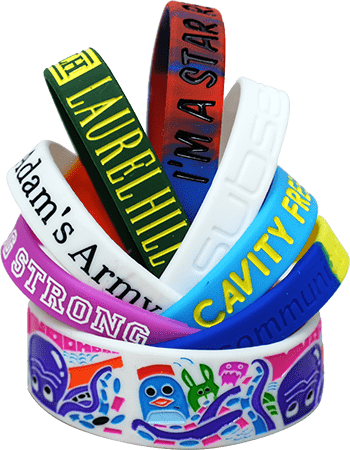Wristbands and bracelets are alike in that they are both worn on the wrist. These two accessories can also both serve decorative and functional purposes. However, the similarities end there. While bracelets have evolved to become fashionable articles of jewelry often made of metals and embellished with precious stones and similarly ornate materials, wristbands became their more utilitarian, more affordable counterpart, which is why they are now often made of such materials as silicone rubber, fabric, plastic, and modern synthetic materials like Tyvek.
Wristbands have various applications, including events management, non-profit funding, sporting activities, school activities, and patient care, among other uses. This is not to say that wristbands can’t be stylish. However, perhaps because of their origins, wristbands began and remained more as a functional accessory compared to bracelets.

Bracelets and Wristbands: A Brief Background
Bracelets and bangles (a bracelet that is made out of a single, inflexible loop) have a more storied past, dating back to 5000 BCE in Egypt. The first bracelets were made of bone, stone, and wood and were mainly used in religious ceremonies or as spiritual accessories. The scarab beetle, which is a symbol of rebirth and regeneration for the Egyptians, often adorned these early versions of the bracelet.
Other ancient civilizations used some form of bracelets made of various materials like strings, corals, metal, and semi-precious stones to ward off evil spirits, pray for bountiful harvests, or shield newborn babies from the interest of wicked creatures.
On the other hand, wristbands are extremely young in comparison. In the late 1940s, British tennis superstar Fred Perry met Tibby Wegner, an Austrian football player who had invented a cloth bracelet designed to wipe sweat from the face and forehead. Perry’s modified design will ultimately become the first wrist-worn sweatband made out of terry cloth. The wristband served as the launching point of the now-popular eponymous clothing brand, Fred Perry.
Jelly Bracelets: Flashy 80s Vogue
While silicone wristbands are now more well-known as sporting accessories, the trend of using gel, rubber, or similar substances can be traced back to the 1980s, when pop royalty Madonna was first seen wearing these accessories. The fad did not last long during that era, although “jelly bracelets” came back into popularity when everything 80s became cool again. Music artists like Pink and Avril Lavigne were indeed seen sporting these bracelets in the late 1990s and early 2000s, while stores like Forever21 and those of other brands that catered to teens and young adults also surfed the wave of this trend.
However, some narratives associated with these accessories were not as wholesome. Urban legends about these jelly bracelets being used as dating bracelets by young people cropped up by 2003. It was similar to the 1970s folklore when pull tabs from aluminum cans and labels from beer bottles were allegedly used as “coupons” for erotic activities.
The issue caused a moral panic at the time, especially since the resurgence of the fashion trend was targeted toward young people. However, according to Barbara Mikkelson of the fact-checking website Snopes, there was little truth in these stories, and that young people have expressed their shock and dismay that adults like their parents and teachers believed a “silly rumor” about a fashion accessory.
Livestrong Wristbands and Beyond
The popularity of silicone wristbands as we know them today may be attributed to pro-road racing cyclist Lance Armstrong, who first sported a bright yellow Livestrong bracelet in 2004. Then known as the Lance Armstrong Foundation, the nonprofit organization’s primary objective is to raise awareness about cancer and generate funds to support patients. Through a partnership with sporting brand Nike, the foundation succeeded in making the silicone bracelet both a fashion and a humanitarian accessory.
In fact, even as the story about Armstrong’s use of performance enhancing drugs caused an uproar in the athletic community, and as Nike severed ties with the Livestrong Foundation, the silicone wristband remained and still continue to be a hugely popular item for charitable institutions and similar organizations. Such wristbands that are used to raise public consciousness about certain issues are even referred to as “awareness bracelets,” like how cancer bracelets raise support for cancer foundations.
Silicone wristbands also gave rise to another wildly popular (and also very controversial) fashion accessory for children. Silly Bandz, bracelets made of silicone rubber formed into various shapes, rose to prominence in the late 2000s, when the owner of BCP Imports Robert Croak saw animal-shaped wristbands in China during a business a trip.
As recounted by Entrepreneur Magazine, Croak thought that the same bracelets would be popular in the United States due to most people’s tendency to fidget. The various designs, on the other hand, could become interesting conversation starters. The company, which also marketed Livestrong bracelets at the time, started developing prototypes upon Croak’s return from China and launched the first batch of Silly Bandz in 2008. The rest, as they say, is history.
Marketing, Branding, and More

Today, silicone wristbands are well-known marketing tools. If you’ve ever been to a trade shows, conventions, and other similar events, you’ve most definitely seen or even been given one of these wristbands. These bracelets usually carry the company name and logo, and sometimes even their slogans. The event organizers themselves may even include a silicone wristband or two in their loot bags or press kits, usually as a keepsake that doubles as a pseudo-ID tag to indicate that you are a participant in the event.
If you want to raise funds for a cause, silicone wristbands are also a great option. They’re very quick and affordable to produce, making them one of the most cost-effective options to generate funds, especially for smaller, lesser known initiatives. But affordable doesn’t mean that only small organizations use silicone wristbands to raise money. Following the footsteps of Armstrong in using these bracelets to support a cause, tennis player Andy Roddick launched iconic blue debossed silicone wristbands for his own foundation with the message “No Compromise.” These wristbands are not only popular among fans, but also with Roddick’s fellow players as well, further spreading the message of the foundation.
Awareness and branding are also easily accomplished with the help of silicone wristbands. In fact, foundations dedicated to medical research use differently colored wristbands—pink for breast cancer, red for AIDS, purple for lupus, among others—to help fuel public curiosity, and hopefully public support as well.
More recently, silicone wristbands have also been used in politics. People can be seen wearing wristbands that show their support for specific candidates, especially during the height of a campaign. Sometimes, wristbands are also used to show one’s support for a piece of legislation (especially controversial ones) to encourage lawmakers to pass or stop a bill.
More Selections from Wristband Creation

We at Wristband Creation are dedicated to providing the best wristbands to our customers. From our wide range of options to our use of the Pantone Matching System, we strive to ensure that each wristband we produce are worth every cent of your investment.
You can choose from seven design wristband styles. Debossed wristbands are the most popular (this is the same style used for the Livestrong bracelets), where the text or design is sunken or engraved to the surface of the silicone. Deboss-filled wristbands have the same style of imprinting, but the sunken portions are filled with ink. This makes the text or design more visible.
Embossed wristbands are the opposite of the debossed style. Instead of engraving the silicone, the text and design are raised above the main surface of the band. You can also choose to have the embossed parts oil-sprayed with the color of your choice. This is our emboss-printed wristband option.
Those looking for the most affordable option that doesn’t scrimp on quality, you can opt for the imprinted wristband. Your preferred design or message will be silk-screen-printed onto the silicone, using high quality paints. Two-toned wristbands are also possible with our dual-layer wristbands. The outer part will be sprayed with your desired color, while the inside and debossed portions will remain the same color as the original silicone. The glossy finish of this wristband gives it a premium look without being too expensive.
Finally, figured wristbands have a circular section on the silicone band. You can put a logo on this part, instead of on the main bracelet, so that the design stands out more than the text. This is especially useful for brands with highly identifiable emblems. Think Google’s round G or the Apple’s well, apple-shaped logo.
Silicone wristbands may not be as fancy as jeweled bracelets, but they’re certainly versatile and still fashionable in their own way. In fact, with the way they’re generating interest about worthwhile causes and helping raise funds for those who need them, you can even say that these humble silicone wristbands are more valuable.



